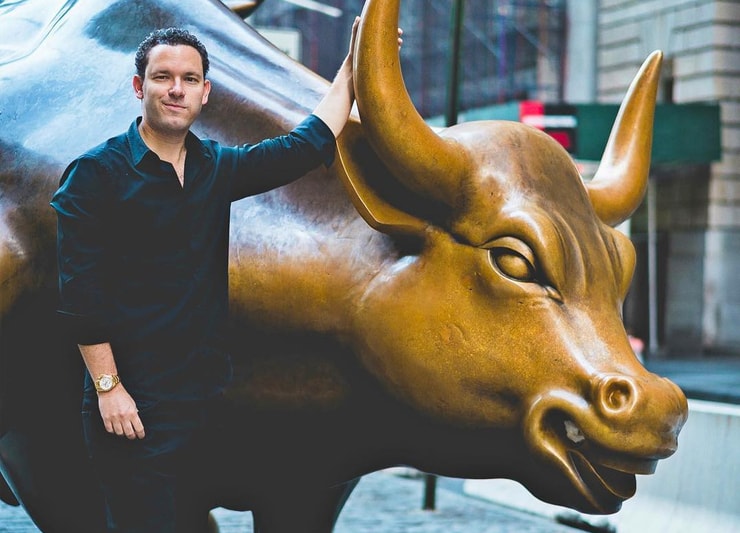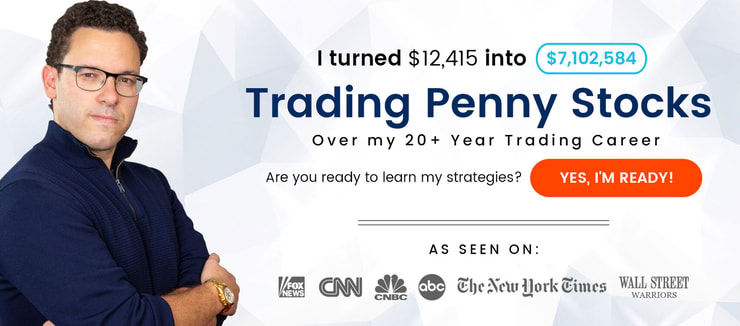FANG Stocks: Key Takeaways
- What traders need to know about these mainstream tech stocks…
- Investors and traders focus on these stocks because they make up almost 25% of the S&P 500.
- For traders, FANG stocks can have limitations, but that doesn’t mean you can ignore them.
I believe the best trading opportunities come from penny stocks. With them, you can study repeatable patterns. These are the patterns my top students used to become self-sufficient…
So I won’t tell you whether to trade FANG stocks. But I want to show you what to know about these stocks and what I think are better ways to trade. Read on.
Table of Contents
- 1 What Are FANG Stocks?
- 2 Why Do FANG Stocks Matter?
- 3 FANG Stocks vs. FAANG Stocks
- 4 FANG Stocks vs. FAAMG Stocks
- 5 Should You Invest in FANG Stocks?
- 6 How to Invest in FANG Stocks
- 7 Is There a FANG Stock Bubble?
- 8 FANG Stock Charts
- 9 What to Expect From FANG Stocks in 2021
- 10 What Are the Next FANG Stocks?
- 11 Alternative Tech Stocks to Watch for 2021
- 12 Frequently Asked Questions About FANG Stocks
- 13 What Is the Best FANG stock?
- 14 Is there a FANG Stocks ETF?
- 15 Why Is Microsoft Not in FAANG?
- 16 Conclusion About FANG Stocks
What Are FANG Stocks?

CNBC host Jim Cramer came up with the term FANG. It’s an acronym for the biggest tech stocks on the market:
- Facebook (NASDAQ: FB)
- Amazon (NASDAQ: AMZN)
- Netflix (NASDAQ: NFLX)
- Google (NASDAQ: GOOG)
The group later expanded to include Apple Inc. (NASDAQ: AAPL), adding a second A to create the FAANG acronym.
The FANG companies became popular after the 2007–2009 recession when their momentum helped get the economy back on track.
Back then, investing in FANG stocks was investing in the future. If you bought them years ago, you could be sitting on a gold mine.
But it’s harder to grow a small account with FANG stocks. It can be done with penny stocks if you have the dedication and work ethic. That’s why I LOVE them.
Want to know why I think penny stocks are such a great opportunity? Get my FREE online guide here.
Why Do FANG Stocks Matter?
FANG stocks represent trillions of dollars in market capitalization. Their performance can directly impact the markets.
They’re also heavily invested in research and development. This sets them aside from other big companies that have struggled to adapt. It drives their continual growth and creates millions of jobs in the process.
These companies are the kings of innovation. They’ve changed the world and probably aren’t going away any time soon.
But that doesn’t mean they’re the best stocks to trade…
FANG Stocks vs. FAANG Stocks
After Jim Cramer first coined the term FANG stocks, others started coming up with their own versions of the acronym. Some traders added an A (FAANG) after deciding that Apple had been unfairly excluded from the original lineup.
I can’t blame whoever first suggested the addition of Apple. With a staggering $2.5 trillion market cap — it’s the most valuable company on the planet.
FANG Stocks vs. FAAMG Stocks
Legendary investment bank Goldman Sachs Group Inc. (NYSE: GS) had different tweaks to the FANG group in mind. Goldman felt that Netflix should be dropped due to its relatively small market cap compared to the other three FANG members.
I can see the logic. As I write this, Netflix has a market cap of $232 billion — 10 times smaller than Apple.
Goldman also thought that not including Microsoft into any of these acronyms was a big oversight, so the bank coined its own term — FAAMG stocks.
Should You Invest in FANG Stocks?

I’ll be the first to admit that I use all of these companies.
I have a presence on Facebook and frequently shop on Amazon. I enjoy watching Netflix, and I use Google anytime I’m online. So I use these companies’ products and services a lot…
But I don’t think their stocks are the best for day trading.
They’re not immune to pullbacks.
There’s also less volatility compared with penny stocks. If you’re a new trader, you might have to wait a long time to grow a small account with the slower-moving FANG stocks.
With penny stocks, the focus is more on price action than on company stories. And you don’t have to hit a home run to make a good trade. Singles add up over time.
FANG Stock Performance
FANG stocks have historically outperformed the broader market.
Look at the five-year percentage gains for the FANG stocks vs. the S&P 500:
- Facebook (NASDAQ: FB) — +184%
- Amazon (NASDAQ: AMZN) — +314%
- Netflix (NASDAQ: NFLX) — +457%
- Google (NASDAQ: GOOG) — +255%
- SPDR S&P 500 ETF Trust (NYSE: SPY) — +102%
As you can see, any one of these stocks would have been a better five-year investment than an index fund. Each FANG stock is practically a household name — and these numbers show it.
But five years is a long time to wait for returns. If you don’t have a large account, is it worth it?
Penny stocks can go completely parabolic. The best setups can sometimes make 400% gains in one day!
My students and I have learned to take advantage of these volatile stocks by day trading them.
For less than $100, you can make a smart investment in your trading education. Learn the market basics and my favorite patterns. Get in my 30-Day Bootcamp today!
Is There a FANG ETF?
There isn’t an exchange-traded fund (ETF) that contains only FANG stocks. ETFs are meant to diversify a portfolio. Having one with only four stocks would defeat the purpose.
AdvisorShares New Tech and Media ETF (NYBOT: FNG) is a close alternative. It has 25 stocks in its bundle, and they’re all related to FANG companies.
How to Invest in FANG Stocks

Let me make one thing clear…
I’m in no way giving you financial advice. All trading is risky. Never risk more than you can afford. Do your own due diligence.
FANG stocks all trade on the Nasdaq. They’re part of the S&P 500. Any standard brokerage or IRA account will let you purchase them.
More Breaking News
- How Nano Nuclear Energy’s New Acquisition is Powering a Stock Surge
- FuboTV Faces Roller Coaster Ride Amid Ongoing Business Turmoil and Legal Scrutiny
- Riot Platforms Inc. Stock: A Rollercoaster with Cryptocurrency’s Wild Swings
The Best Way to Buy FANG Stocks

Before you buy FANG stocks, there are a few things to consider…
They usually trend upward because of how popular they are for long-term investors. But you can’t just blindly buy anywhere.
FANG stocks usually move together. The best time to buy is during a market dip. A great example took place just last year. In March 2020, the markets crashed to levels we hadn’t seen in a while.
The FANG stocks all pulled back, offering a good buying opportunity. Any kind of bad news can lead to a pullback. It’s important to wait for one so you avoid buying at the top.
Penny stocks don’t require such a complicated approach. Trading them is still a ton of hard work. But the trades are usually a lot faster … which is why I think they’re the better stocks to trade.
How to Short FANG Stocks
Unlike penny stocks, FANG stocks are almost always liquid. That means there are always shares available to short. Most of the time, the shares are easy to borrow … your only fees should be short interest.
Plus, some large companies offer options to increase leverage. But the question isn’t if you can short FANG stocks … It’s if you should.
For years, these stocks have been the strongest in the market. They haven’t been pumped up by chat rooms or promoters. There’s little to no dilution disclosed in their SEC filings.
Unless you were shorting these stocks before the March 2020 crash, there’s no real reason to short them now. They’ve all recovered.
I think shorting is dangerous in general. My best plays are from going long on penny stocks.
Is There a FANG Stock Bubble?

©
The thing with bubbles? Most people don’t know about them until they pop.
It’s hard to ignore how high some of these valuations are after the crazy price action we’ve seen this past year and change. But let’s put things in context…
The crash in March 2020 made many investors nervous, but the FANG stocks recovered. The entire group bounced off those lows to new all-time highs.
Based on the price action of the FANG stocks, I don’t think they’re in a bubble. If it was a bubble, it should’ve burst when the FANG stocks plummeted last year. But they all bounced back.
These companies are well-capitalized cash fortresses. And they’re still growing every year. There’s plenty of room for them to expand further. Artificial intelligence and big data are just a few areas that hold potential for more growth.
When day trading penny stocks, you can worry less about a potential bubble. Opportunities come on a day-to-day time frame. Your money isn’t locked up long term.
It’s another big reason I prefer to only trade penny stocks!
Want to know what stocks I’m watching this week? Sign up for my weekly watchlist!
FANG Stock Charts
Let’s check out the charts…
FB Daily Chart
AMZN Daily Chart
NFLX Daily Chart
GOOG Daily Chart
What to Expect From FANG Stocks in 2021
One of the most interesting moves of the year in FANG stocks (sorry, FAANG) has been Apple’s recent huge rally. After unexpectedly attracting the interest of WallStreetBets traders, the stock went on a parabolic run starting in June. And it continued to soar into July.
That’s notable because of Apple’s massive market cap. It takes a huge amount of money to move Apple — 10% of the company is worth $250 billion.
Compare these numbers to the average penny stock. One reason penny stocks are so volatile (and my favorite stocks to trade) is that their market caps and floats are tiny. A bunch of traders can rally and control half of the float of a penny stock overnight.
But Apple’s a different story. Moving this stock requires not millions, but BILLIONS of dollars (at a bare minimum). That’s a LOT of traders.
That’s why I think there are better stocks to trade than FANG stocks. Again, it’s rare that these massive companies make huge moves that day traders can take advantage of.
But it’s still worthwhile to consider the future of FANG stocks…
AAPL Daily Chart
What Are the Next FANG Stocks?
Wish you’d bought FB on IPO day? Join the club…
Buying any of the FANG stocks 10 years ago would have made you a pretty penny, but hindsight’s 20/20. After you realize how powerful and impressive these companies are today, it’s natural to wonder what the next FANG stocks will be.
With that in mind, let’s take a look at three possible candidates for a future spot in the next FANG stocks lineup…
Alternative Tech Stocks to Watch for 2021

1. Tesla Inc. (NASDAQ: TSLA)
It seems like ages ago that Tesla Inc. (NASDAQ: TSLA) was trading on top of a sub-$100 million market cap, but it was just last year. Elon Musk’s next-generation electric vehicle company surged more than 700% in the past 18 months. It’s at a valuation of $688 billion at the time of this writing.
For such a big company, the major upside move in Tesla stands out. One contributing factor was the company’s 5-to-1 stock split announced in mid-August 2020…
This is why knowing your history is critical. We’ve seen stock splits spark massive rallies throughout the past few years.
That being said, it’s rare that a company of this size adds so much value so quickly. To put things in perspective, Tesla is now the seventh most valuable company in the world by market cap. If this trend continues, we could see a new FANG acronym that includes a T in the future.
But Tesla isn’t alone. Another company that recently split its stock has been making waves of its own…
2. NVIDIA Corporation (NASDAQ: NVDA)

Unless you’ve been living under a rock, you probably heard about Nvidia Corporation’s (NASDAQ: NVDA) highly publicized 4-to-1 split that took place on July 22.
After the split announcement, Nvidia shares did a victory lap, adding 35% in less than three weeks. Since the beginning of 2019, the stock has boosted a mind-blowing 500%.
Nvidia has many similarities to Tesla on this topic — both are massive companies that have grown several multiples larger in just a few short years. And both of their market caps are now north of half a trillion.
Only 13 companies in the world have $500 billion+ market caps, making these two obvious considerations for any updated FANG stock list in the future.
Additionally, Nvidia and Tesla have a lot in common with the mega-cap tech giants that already make up the FANG stocks…
- Well capitalized? Check.
- Industry leaders? Check.
- Breakthrough technology? Check.
Nvidia’s firm grasp over the graphics card industry could very well catapult the shares even higher in the coming years. And if its market cap continues to move toward the highly-coveted $1 trillion mark, watch out for a potential name like FAANNG stocks.
3. Alibaba Group Holding Limited (NYSE: BABA) and Tencent Holdings Ltd. (OTC: TCEHY)
So far, FANG stocks have all been U.S. companies. But if the acronym were to include Chinese companies, Alibaba Group Holding Limited (NYSE: BABA) and Tencent Holdings Ltd. (OTC: TCEHY) would be the businesses to start with…
Tencent is everywhere in China. As a conglomerate, it owns several household-name tech brands like WeChat, Tencent QQ, Tencent Music, Tencent Video, HUYA, and “League of Legends” developer RIOT Games.
Imagine if one U.S. holding company owned Zoom, Spotify, Apple Music, Activision/Blizzard, and Netflix. Even then it’s hard to imagine the extent of Tencent’s dominance over Chinese tech.
It’s the largest video game vendor in the world, as well as the first-ever Chinese company to pass a $500 billion market cap. Currently, Tencent is the tenth most-valuable company in the world by market cap.
And right below Tencent on this list at number 11 is Alibaba. Here, the comparison seems obvious. After all, the Chinese e-commerce giant is regularly called the ‘Amazon of China.’
While recent negative news headlines surrounding visionary co-founder Jack Ma have hurt the share price in the near term, Alibaba continues to grow every year. It’s quietly narrowing the gap with its American counterparts in online shopping.
Just as Tesla and Nvidia are making huge moves stateside, Tencent and Alibaba are quietly establishing total control over their respective markets in China.
I think any of these four companies could get added to a future list of FANG stocks.
Frequently Asked Questions About FANG Stocks
What Is the Best FANG stock?
That’s hard to say, but on a near-term basis, 2021 has been notable for Google stock. The undisputed king of search engines (and ad revenue) outpaced every one of its FANG colleagues since January, up more than 50% YTD.
Is there a FANG Stocks ETF?
Yes, there are several FANG Stocks ETFs. If you’re looking for the closest thing to a pure play on FANG stocks, there’s Global X Millennial Consumer ETF (NASDAQ: MILN). This ETF only invests in U.S. companies and all of the FANG stocks are included in its holdings.
Why Is Microsoft Not in FAANG?
Good question. Maybe Cramer didn’t drink enough coffee the morning he coined the term. Luckily, investment bank Goldman Sachs had the same question. Goldman coined the term FAAMG stocks to make up for Microsoft and Apple’s mysterious exclusions from the original FANG stocks lineup.
Conclusion About FANG Stocks
Some financial institutions want you to believe FANG stocks are the hottest thing in the market.
That’s simply not true. Maybe you’ll see returns if you wait a long time, but there’s always risk involved.
In my opinion, there are way better trading styles available. If you have a small account, day trading can lead to growth much quicker than buying FANG stocks. It comes down to how much effort you put into your education.
The TV talking heads hate penny stocks! But I love this niche, and I wouldn’t be where I am without these junk stocks.
You don’t need to trade FANG stocks to become self-sufficient. If you focus on the right material, you can work to adapt and trade through any market.
What’s your take on FANG stocks? Let me know in the comments!
Disclaimer
*While Tim Sykes has enjoyed remarkable success trading stocks over the years, his primary income derives from the sale of financial education products and subscription services offered by various businesses and websites in which he has an ownership stake.
Results are not typical and will vary from person to person. Making money trading stocks takes time, dedication, and hard work. Most who receive free or paid content will make little or no money because they will not apply the skills being taught. Any results displayed are exceptional. We do not guarantee any outcome regarding your earnings or income as the factors that impact such results are numerous and uncontrollable.





Leave a reply